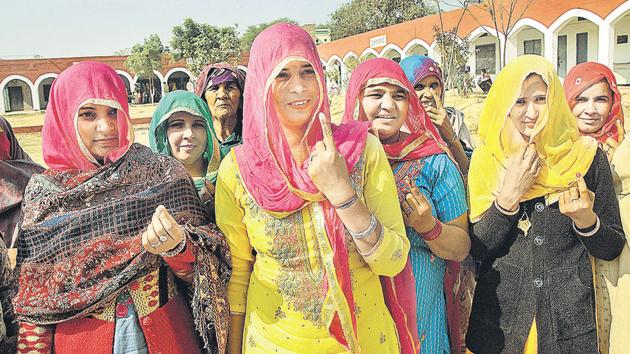Opinion | The 2019 election game has begun
The 2019 election maybe fought across 543 seats, but it is the 80 seats of Uttar Pradesh that hold the key to unlocking the door to power in Delhi. This is because UP is the only state where the BJP appears set to lose big time.
This is the season for opinion polls with hyperventilating TV anchors throwing a volley of numbers at dazed viewers with an authority that at times belies the spotty track record of many pollsters. At least, most 2019 election forecasts are broadly pointing in the same direction with six major trends emerging from these findings.

First, a hung Parliament seems the most likely verdict. Second, the BJP is unlikely to come anywhere close to repeating its remarkable 282-seat majority of 2014, but is still India’s party number one by some distance.
Third, the Congress has gained some traction in the last year but is, much like the Australian batsmen in the recent Test series, still struggling to cross the century mark.
Fourth, the BJP and the Congress between them are hovering around the 300-seat mark, leaving a large space open for the non-Congress, non-BJP parties to play a crucial role in post-poll combinations. Fifth, Narendra Modi is still clearly neta number one, although the gap between him and Rahul Gandhi has reduced as the anti-incumbency space widens.
Sixth, the 2019 election maybe fought across 543 seats, but it is the 80 seats of Uttar Pradesh (UP) that hold the key to unlocking the door to power in Delhi. This is because UP is the only state where the BJP appears set to lose big time: An average of around 40-50 seats, according to polls. The newly formed Samajwadi Party (SP)-Bahujan Samaj Party (BSP) alliance will be the big gainer. In effect, while the chemistry may still be with Modi as the most popular leader in the country, in the UP context, the sheer arithmetic of a wide alliance makes it a mountain to climb for the BJP.
Follow live updates of Budget here
Enter Priyanka Gandhi Vadra as the Congress general secretary in charge of eastern UP. Her arrival in formal politics was greeted with euphoria by party cheerleaders. A charged up Rahul Gandhi has added to the buzz by claiming that his sister’s appointment in the crucial battleground state is proof that the Congress is playing the elections “on the front foot”. Indeed, the political messaging from Priyanka Gandhi’s appointment is clear: the Congress believes that after scoring a hat trick of wins in the December assembly elections, it is back in the game.
But the truth is no two elections are the same. The assembly elections were fought as direct BJP versus Congress fights in those Hindi heartland states where there was strong local anti-incumbency and no viable third alternative. In UP, there is a clear and potent option in the Mayawati-Akhilesh Yadav combine, one that has the caste arithmetic and the organisational strength to take on the BJP’s Hindutva mobilisation. The Congress has neither. Instead, the party is banking on a sentimental goodwill through the prism of sepia-tinted nostalgia.
Yes, the charismatic Priyanka Gandhi will get media attention and enthuse Congress workers, but can she shift votes? More importantly, even if she does, whose votes would the Congress end up eroding? In 2014, a CSDS post-poll survey showed that the BJP won 72% of the upper caste vote across UP while the SP and BSP between them won 75% of the Muslim vote. In eastern UP, where upper castes and Muslims are in substantial numbers, any surge in Congress votes — the party won barely 6% of the vote there in 2014 — could come at the expense of both the other major formations, essentially adding a new dynamic to the poll equations.
For detailed budget coverage, click here: https://www.livemint.com/
Which raises the critical question: Is the 2019 election for the opposition, especially the Congress, about Congress maximisation or BJP minimisation? In its quest to be more aggressive, is the Congress risking the possibility of playing into the BJP’s hands by splitting the anti-BJP vote? To take the Australian cricket tour analogy again, Cheteshwar Pujara was the most successful Indian batsman because he knew which ball to play and which to leave. Uttar Pradesh perhaps was the bouncer the Congress needed to duck instead of seeking to compete with potential post poll allies.
Which is why the Congress needs to take a big call soon: Is the battle for 2019 about a serious attempt to make Rahul Gandhi the prime minister or about stitching as many alliances as possible to try and defeat Narendra Modi even if it means compromising on prime ministerial ambitions? Think about another opinion poll takeaway: According to the India Today Mood of the Nation poll, an SP-BSP-Congress alliance in UP could reduce the BJP to just five seats in the state. In effect, 2019 boils down to Modi’s chemistry versus gatbandhan arithmetic. Game on!
Post script: Allow me to borrow a classic one liner from a colleague during our opinion poll programme. Asked what impact Priyanka Gandhi’s entry would have, the seasoned analyst, tongue firmly in cheek remarked, “It is one thing to have your behen (sister) on your side, but what Rahul Gandhi really needs is ‘behenji’ (Mayawati) with him!”
Rajdeep Sardesai is senior journalist and author
The views expressed are personal






